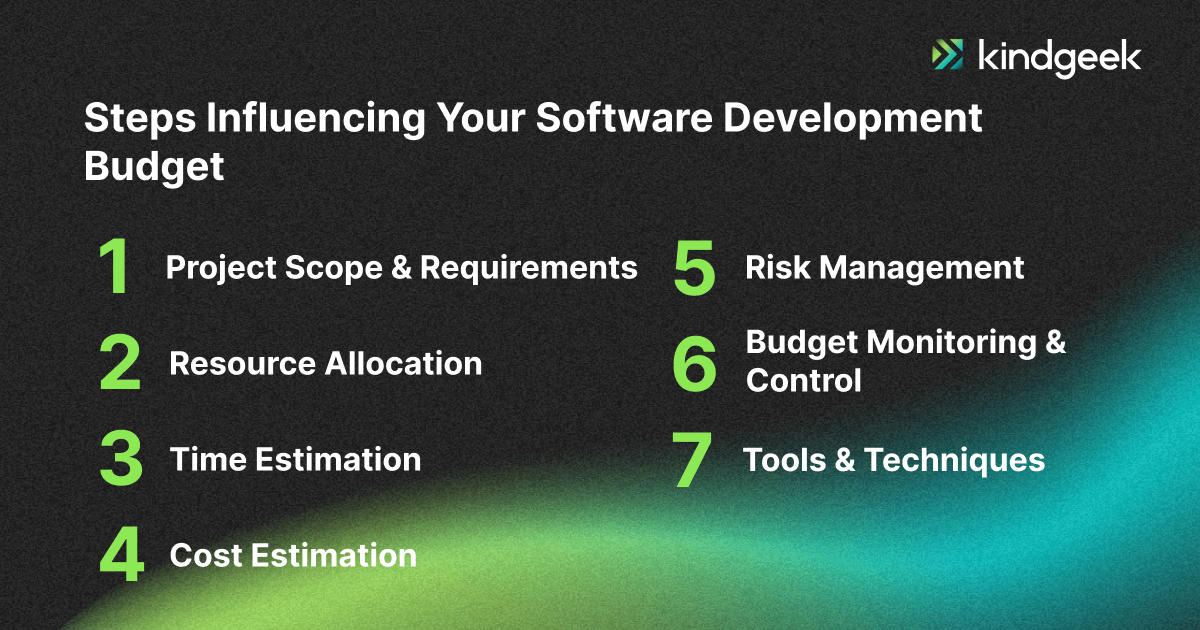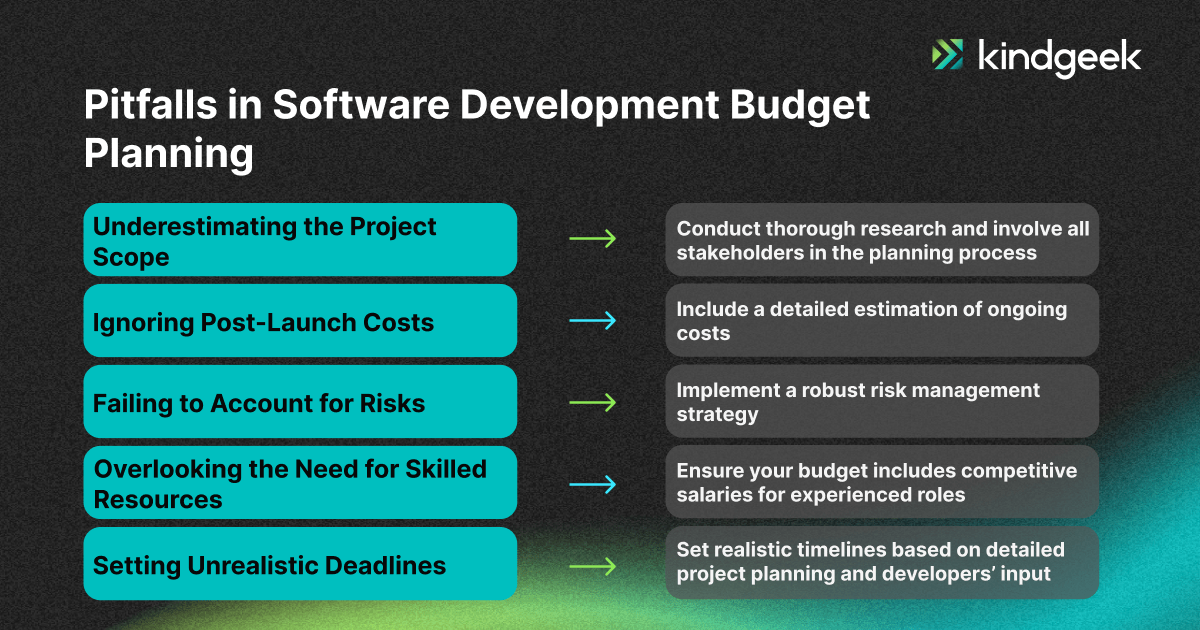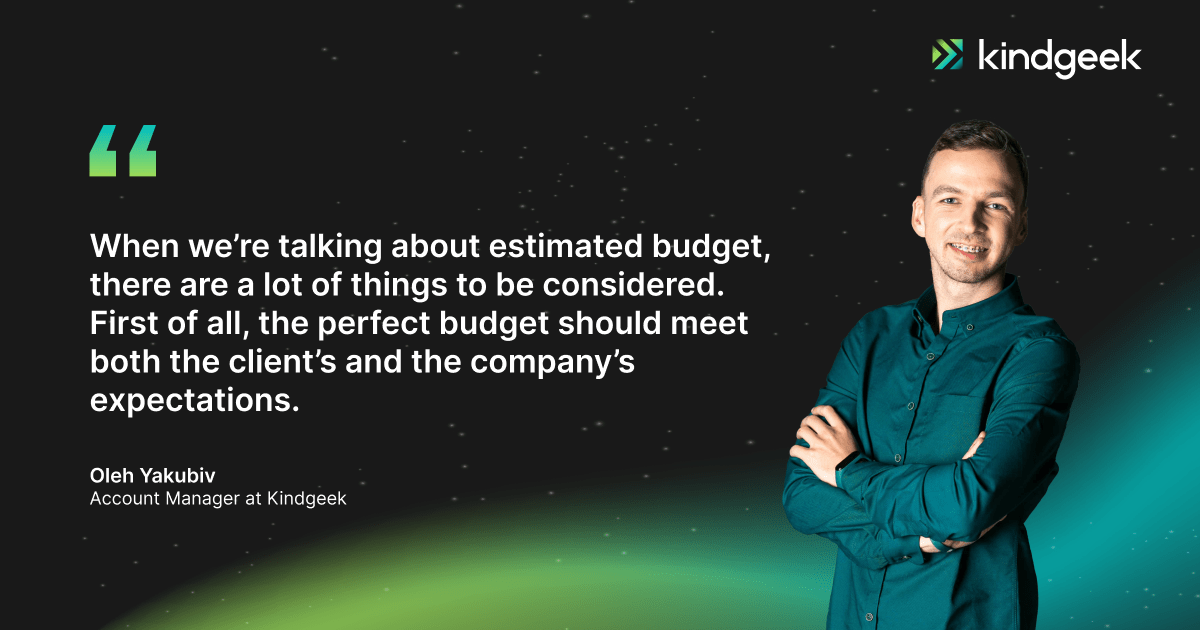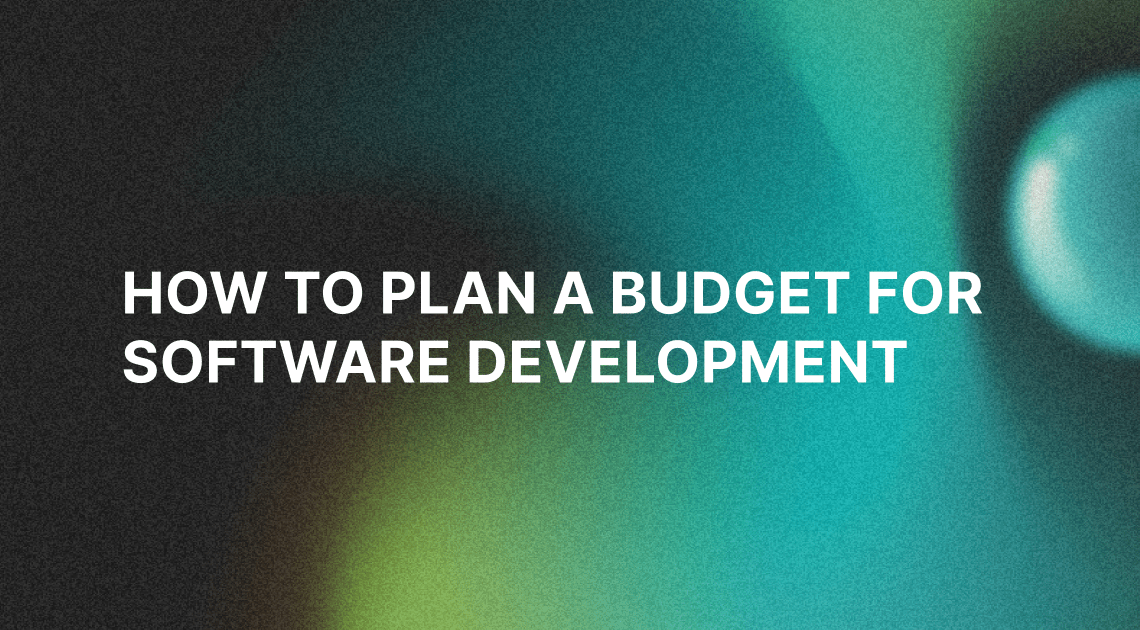Recently updated on August 2, 2024
When it comes to creating a budget for software development, every $ counts. Proper budgeting helps manage resources efficiently and avoid financial pitfalls.
Whenever we work with startups or enterprises, we strive to be as accurate, transparent, and flexible in our estimates as possible. In the Clutch article about creating a software project cost estimate, Yuriy Gnatyuk, COO of Kindgeek, mentioned that the success of a software development estimate hinges on effective communication with the client, with accuracy being a close second.
That is why we have gathered some tips and tricks for creating a cost estimate that is both accurate and easily understandable for clients.
We will outline seven steps to help you learn how to plan a software development budget based on the successful methods we’ve implemented in our projects.
Content:
- 7 Steps Influencing Your Software Development Budget
- How to Keep Your Budget in Check
- Thoughts on Crafting a Perfect Software Development Budget and Estimate
- Consider Kindgeek Your Trusted Healthcare Software Development Partner
- Final Thoughts
7 Steps Influencing Your Software Development Budget

1. Project Scope and Requirements
Defining the Scope
Clearly outline the goals, deliverables, and boundaries of your application. This includes identifying the main functionalities and feature set.
If the client comes to us without a clear vision of how exactly the product will look, we suggest conducting a discovery phase. Business analysts investigate the functionality of a future project in detail and its place in the modern market. It allows us to test products before the implementation phase, saving costs and up to 20% of the time for development.
Gathering Requirements
Engage all relevant stakeholders and end users to gather their input and ensure their expectations are met. Document detailed requirements, including both functional and non-functional aspects, to provide a comprehensive understanding of the project’s needs. At Kindgeek, we believe that asking the right questions is crucial for the project’s success. The more answers you receive, the better—for you and the client.
2. Resource Allocation
Team Composition
Identify the necessary skills and roles for the project, including developers, QA testers, project managers, DevOps specialists and UI/UX designers. Your team’s size and skill level will significantly influence the budget.
Software Size and Type
Another crucial aspect is the technology stack. In addition to human resources, you will need to identify the necessary equipment, software, and third-party integration, all of which come with associated costs.
Resource Availability
Make sure resources are available when needed and plan for any possible shortages.
3. Time Estimation
Create a detailed project timeline with milestones and deadlines. This can be achieved in collaboration with project managers and team leaders. Extended development timelines can result in higher operational expenses, while tighter deadlines require additional resources to streamline the process.
4. Cost Estimation
Accurate cost estimation helps set realistic expectations and ensures you have the necessary funds to complete the project successfully. Here’s how to prepare a budget for software development:
Types of Costs
To effectively budget for software development, it’s essential to break down the costs associated with each resource. Consider both direct costs (which can be easily attributed to the project) and indirect costs (such as administrative expenses and office space).
- Direct costs: Calculate costs such as salaries, equipment, and software licenses.
- Indirect costs: Consider overhead costs like administrative expenses, office space, utilities, and general operational costs.
Budget Calculation
To determine the overall budget:
- Sum up costs: Add up the costs for each task and activity.
- Create a detailed breakdown: Show how funds are allocated to various aspects of the project, ensuring transparency and comprehensive financial planning.
By following these steps, you can create a thorough and realistic budget for software development project needs.
5. Risk Management
Identifying Risks
List potential risks that could impact the project. This includes technical, financial, and operational risks.
Risk Mitigation Strategies
Develop strategies to minimize the impact of identified risks. This includes creating backup plans and alternative solutions.
6. Budget Monitoring and Control
Tracking Expenses
Regularly track and compare actual expenses against the budget. This helps in identifying deviations and taking corrective actions.
Financial Reporting
Prepare regular financial reports to keep stakeholders informed about the budget status.
7. Tools and Techniques
Budgeting Software
Use dedicated systems to streamline the budgeting process. Financial management software can track expenses, create budgets, and monitor financial performance.
Project Management Tools
Incorporate project management tools to manage tasks, resources, and timelines effectively. These tools help in organizing and overseeing various project elements.
How to Keep Your Budget in Check
Besides knowing how to prepare a software development budget, keeping it at the right level is crucial. Here are some tips:
Establish Budget Baselines
Break down the budget into detailed categories such as development, testing, deployment, and maintenance. Based on thorough research and past experiences, define specific cost estimates for each category.
Review the Budget Regularly
Schedule monthly or bi-weekly budget reviews to compare actual spending against the planned budget. Use project management and finance management tools to track expenses in real time, making it easier to spot trends and adjust forecasts as needed.
Foster a Collaborative Team Environment
Transparent communication, knowledge sharing, and teamwork among stakeholders, project managers, and development teams are essential for budget control. Establish regular meetings to discuss budget status, potential risks, and changes in project scope. Ensure all stakeholders have access to reports and understand the financial implications of their decisions.
Prioritize Features and Phases
Not all features are critical for the initial release. Prioritize features based on their value to the end-users and the project’s goals. Focus on delivering the most important functionalities first and plan additional features for future phases.
Monitor and Mitigate Risks
Identify potential risks, like technical challenges and resource availability, early in the project and develop mitigation strategies. Create a risk management plan that includes a contingency fund to address unexpected issues.
Even if you know how to budget software development most efficiently, some pitfalls are inevitable. So, it’s essential to understand and prepare for these challenges to navigate them effectively. Here are some examples:

Underestimating the Project Scope
One of the most significant pitfalls is underestimating the project scope. This can lead to insufficient budget allocation, causing financial strain as the project progresses. To avoid this, conduct thorough research and involve all stakeholders in the planning process to touch upon every aspect of the project.
Ignoring Post-Launch Costs
Many budget plans focus solely on the development phase, overlooking post-launch expenses. Ignoring these costs can lead to financial shortfalls after the software is deployed. To ensure the project remains sustainable long-term, include a detailed estimation of ongoing expenses — factor in regular updates, bug fixes, and user support.
Failing to Account for Risks
Every project carries inherent risks, from technical challenges to changes in the market. Failing to account for these risks can result in significant budget overruns. Implement a robust risk management strategy that includes identifying potential hazards, assessing their impact, and allocating a contingency fund to address them.
Overlooking the Need for Skilled Resources
The success of any web or mobile app heavily depends on the expertise of the development team. Overlooking the need for skilled resources can lead to poor-quality work and increased costs due to rework. Ensure your budget includes competitive salaries for experienced developers, project managers, and other key roles. Additionally, allocate funds to keep the team’s skills up to date.
Setting Unrealistic Deadlines
Setting overly ambitious deadlines can pressure the development team to rush, leading to substandard work and increased costs due to the need for rework and potential delays. Unrealistic timelines can also demoralize the team, reducing productivity and efficiency. Establish realistic timelines based on detailed project planning and input from experienced developers.
By avoiding these common pitfalls, you can create a more accurate and comprehensive plan for your software development project budget.
Thoughts on Crafting a Perfect Software Development Budget and Estimate
We asked Oleh Yakubiv, an account manager at Kindgeek, to share his thoughts on preparing a budget for software development, and he emphasized the importance of both client and company satisfaction, stating, “When we’re talking about estimated budget, there are a lot of things to be considered. First of all, the perfect budget should meet both the client’s and the company’s expectations. The client should indicate at least the best (optimistic) / worst (pessimistic) case scenarios to understand whether they or their investors can cover this budget. The company should make a reasonable profit.
The budget should consider possible risks and their cost. It also needs to consider the project timeline (duration), team composition, and its members’ salary reviews. It should include a contingency to cover estimate uncertainties. It also should not be 100% fixed – there should always be room for a change because we don’t live in constants, but much rather in variables.”

Our ultimate software development budget example covers the following:
- Finding out the client’s expectations
- Figuring out the client’s budget
- Crafting a comprehensive estimate
- Evaluating the risks and including out-of-scope expenses
Consider Kindgeek Your Trusted Healthcare Software Development Partner
Kindgeek is a software development company that builds innovative and secure software solutions. We match our engineering culture to your core values to deliver custom software development services to startups, small to medium businesses, and enterprises. Our approach is:
Product-oriented
We want our customers to succeed with the industry-shaping products we build together. To this end, we research the market, analyze data, and apply design thinking to develop relevant solutions.
People-first
We recommend starting every project with a discovery phase. This phase allows us to learn about the needs and habits of product users and build easy-to-use, user-oriented products.
Innovative
At Kindgeek, we believe in innovations and startups. We constantly add new technology to our stack to turn the most challenging ideas into innovative medical software development projects.
Final Thoughts
Creating a budget estimate is one of the most essential processes, along with developing software. Despite its complexity, following the steps we’ve compiled will help ensure that you have everything required for the most accurate estimate possible.
To create a more adaptable budget plan, it’s also essential to understand and avoid pitfalls, from underestimating the project scope to setting unrealistic deadlines. This approach not only helps keep the budget on track but also ensures the successful completion of your software development project.
How to create a software development project budget plan?
Recently updated on August 2, 2024
To create a software development project budget plan, define the project scope, estimate costs for each phase, and include a contingency fund for unexpected expenses. Regularly review and adjust the budget to ensure it remains aligned with actual expenditures and progress.
What percentage of a software development budget should be testing debugging?
Recently updated on August 2, 2024
It largely depends on the complexity of the project. However, our experience shows that testing debugging takes up around 30-40% of a software development budget.
How to determine project budget for software development?
There are several techniques for determining the budget for a project. One of the most popular ones is breaking down the project into small tasks, determining what technologies you will need, and then estimating the time for each task and the average rate of developers needed to complete the project.




